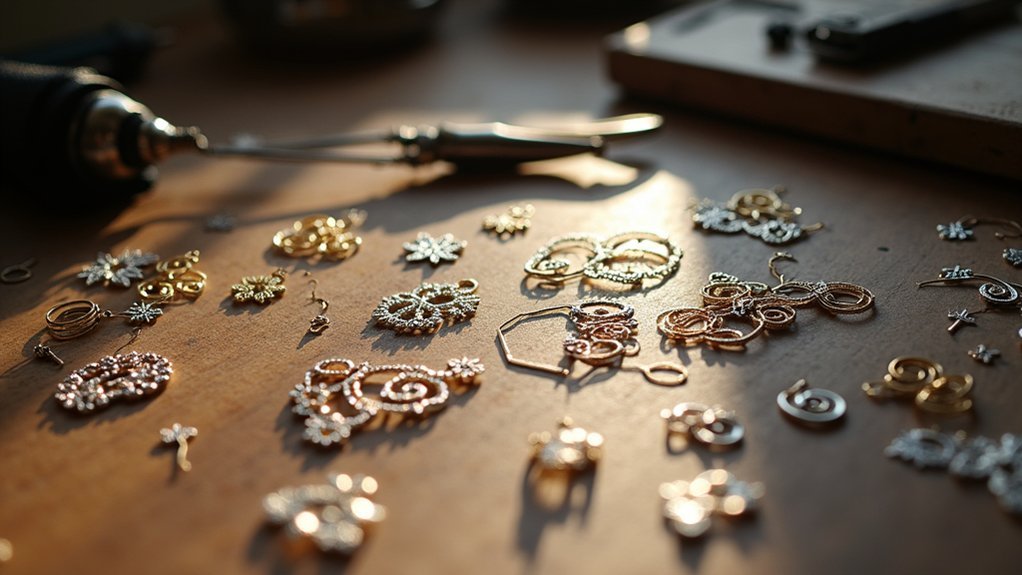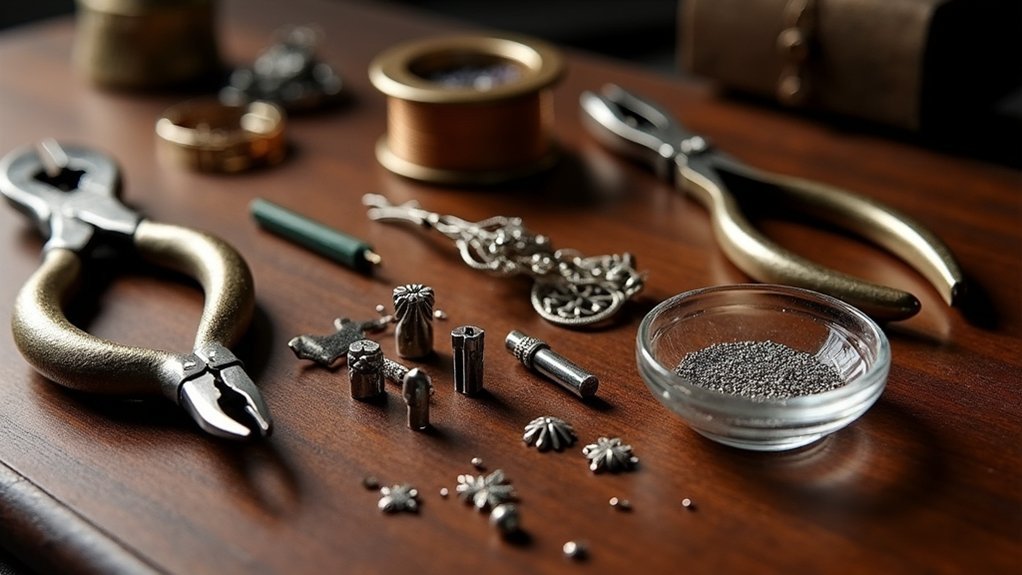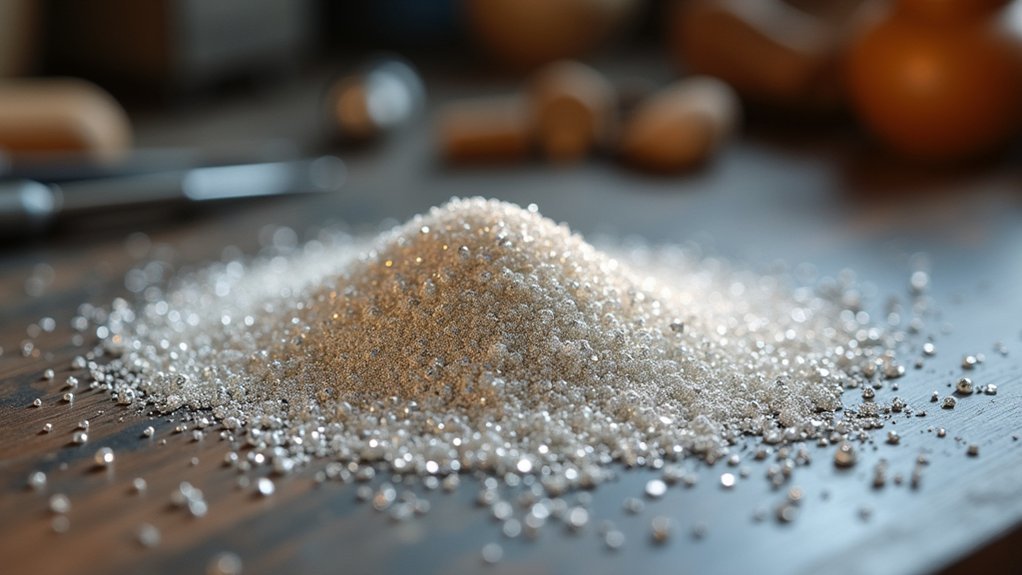Your filigree jewelry’s success hinges on one critical decision that’ll make or break your design before you even begin shaping your first curve. You’ve probably struggled with wire that’s either too thick for intricate details or too thin to maintain structural integrity. The difference between amateur-looking pieces and museum-quality filigree often comes down to matching the right gauge to your specific technique, and there’s a systematic approach that’ll transform your metalworking results.
28-Gauge Wire for Ultra-Fine Filigree Details

When creating ultra-fine filigree details, you’ll want to reach for 26-gauge wire as your primary choice, since it delivers the perfect balance between workability and structural integrity for delicate patterns.
This Wire Gauge provides enough flexibility to bend into intricate shapes while maintaining the strength needed to support your design.
For exceptionally detailed work, you can step down to 28-gauge wire, which allows for even more elaborate patterns and tighter curves.
Always choose Dead soft wire for these applications, as it’s far easier to manipulate without snapping mid-project.
Before you begin any Jewelry Making session, remember to anneal your wire properly.
This process removes internal stress and keeps the material pliable throughout your work, preventing frustrating breaks during complex shaping.
26-Gauge Wire for Delicate Scrollwork and Patterns
How do you achieve those stunning scrollwork patterns that make filigree jewelry so enchanting?
You’ll want to reach for 26-gauge wire as your go-to choice for delicate scrollwork. This gauge wire strikes the perfect balance between flexibility and strength, allowing you to create intricate designs without constant breakage concerns.
For your filigree techniques, always use dead soft wire since it bends easily into complex patterns while maintaining structural integrity.
Remember to anneal your wire before starting work – this essential step enhances malleability, especially important for detailed scrollwork.
Annealing your wire beforehand is crucial for achieving the flexibility needed for intricate filigree scrollwork patterns.
When pursuing finished elegance, aim for wire dimensions of 29-30 gauge thickness with 17-18 gauge width.
These specifications help you achieve the refined, delicate scrollwork that defines masterful filigree jewelry pieces.
24-Gauge Wire for Structural Framework Elements

While delicate scrollwork forms the artistic heart of filigree jewelry, you’ll need stronger wire gauges to create the structural framework that supports these intricate patterns.
For most structural framework elements, you should use wire gauge between 20 and 26, with 20 gauge providing maximum strength and 26 gauge offering more delicate support.
When crafting larger filigree pieces, consider 18 gauge wire for your base structure to guarantee stability while maintaining design flexibility.
Dead soft wire remains your best choice for framework elements since it’s easier to manipulate into complex shapes and curves.
Remember to anneal your wire regularly during construction to maintain malleability and prevent breakage.
Balance your wire gauge selection based on your design’s complexity, prioritizing strength where needed while preserving the delicate aesthetic that defines exceptional filigree work.
22-Gauge Wire for Bold Filigree Designs
For bold filigree designs that demand visual impact without sacrificing structural integrity, 20 to 22 gauge wire delivers the perfect combination of strength and workability. You’ll find this range allows intricate patterning while maintaining enough substance for pronounced visual appeal.
When your designs require even bolder statements, 18 gauge wire works exceptionally well, creating more structural and prominent elements without completely sacrificing detail work.
Twenty gauge wire provides approximately 19 feet per ounce, making it cost-effective for larger projects.
Twenty gauge wire’s generous 19-foot-per-ounce ratio makes it an economical choice for ambitious filigree projects requiring substantial material.
While 16 gauge can serve foundational purposes in filigree work, it considerably reduces your design’s intricacy due to limited pliability.
Always anneal your wire before beginning work, especially with thicker gauges, to enhance malleability and prevent cracking during manipulation.
20-Gauge Wire for Mixed-Media Filigree Projects

Mixed-media filigree projects present unique challenges that require different wire gauge considerations than traditional single-metal approaches.
You’ll find that 26-gauge wire offers the perfect balance of strength and flexibility for these complex designs, allowing you to manipulate intricate elements without constant breakage concerns.
For detailed work, consider incorporating 28-gauge wire to create delicate accents that won’t overpower your mixed materials. Always choose dead soft wire for easier manipulation and more flowing curves in your designs.
Before starting any filigree work, you must anneal the wire to prevent frustrating breaks during shaping.
For structural elements, 24-gauge wire provides excellent foundation support while maintaining compatibility with finer decorative gauges throughout your mixed-media composition.
Frequently Asked Questions
What Is the Best Wire Thickness for Jewelry Making?
You’ll want different wire gauges depending on your project. For general jewelry making, use 18-22 gauge for structural elements, 24-26 gauge for wrapping, and 20 gauge for ear wires and jump rings.
What Is Better, 16 or 18 Gauge Wire?
You’ll find 18 gauge wire’s better for delicate, intricate filigree work since it’s more flexible and easier to manipulate, while 16 gauge offers superior strength for larger, structural components.
What Gauge Wire Is Best for Beaded Bracelets?
For beaded bracelets, you’ll want 20-22 gauge wire as your go-to choice. Use 24 gauge when you’re working with smaller bead holes, and consider 26 gauge for delicate wire weaving details.
How Thick Should Beading Wire Be?
You’ll want beading wire between 0.014 to 0.024 inches thick. Choose thinner wire for delicate beads and lighter designs, while thicker wire works better for heavier beads and more durable bracelets.
In Summary
You’ve now got the essential wire thickness knowledge to elevate your filigree jewelry making. Whether you’re crafting intricate details with 28-gauge or building bold statement pieces with 22-gauge, each thickness serves its specific purpose. Don’t be afraid to experiment and combine different gauges within a single piece. Your choice of wire will determine both the aesthetic appeal and structural integrity of your finished jewelry, so choose wisely for each project.





Leave a Reply